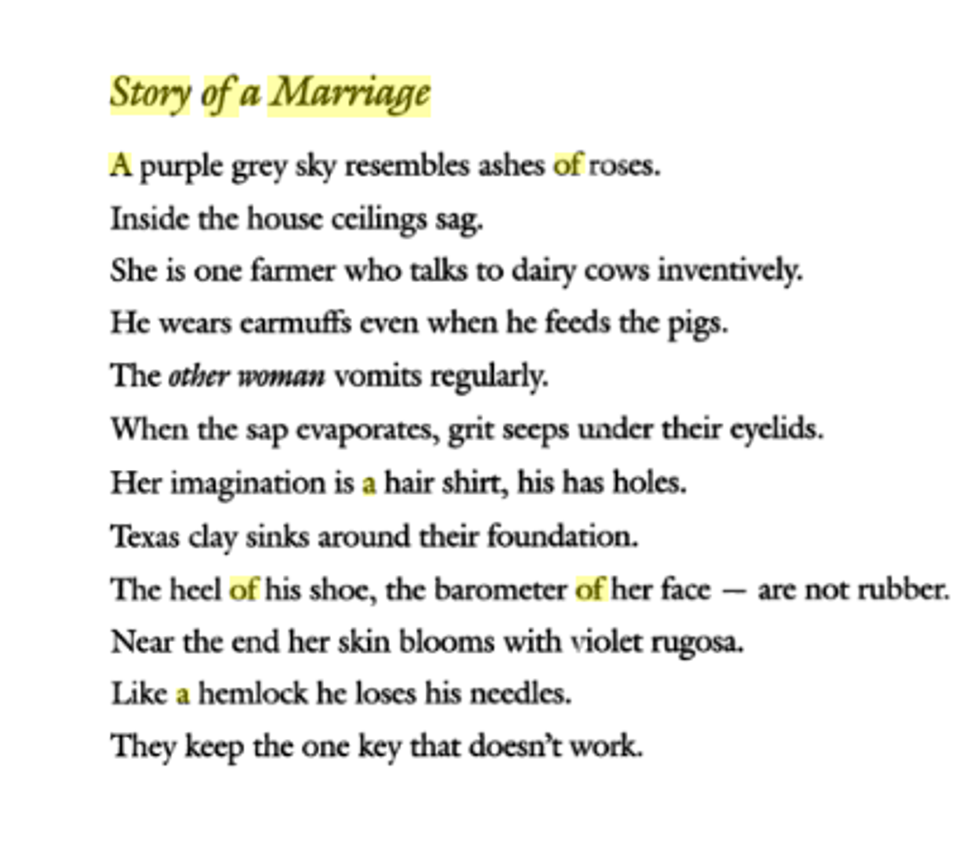Natasha Saja, Story of a Marriage
This poem is very imagistic in language, and very abstract in presentation. There are only 9 lines, each ending in a period. The periods seem to mark both the end of the line, and the end of a thought/observation. There are absolutely no extraneous words; each letter placed on the page appears to be meticulously thought out. Throughout the poem, themes of nature and livestock are repeated. “Ashes of roses” possibly refers to the death of something beautiful, and also references the subject matter of a line that comes later in the piece, “near the end her skin blooms with violet rugosa”. Rugosa are flowers that have very deep, pink and red wrinkles all over; this could be symbolic of old age or of sexuality. “Inside the house ceilings sag” makes me think that it is the former; ceilings sagging is a sign of an exhausted foundation. The previous line foreshadows the death of something beautiful, and the next line is there to back up that claim with the idea of being worn out, tired, old, broken. The next two lines talk about livestock; “she is one farmer who talks to dairy cows inventively”, “He wears earmuffs even when he feeds the pigs”. The first of the two appears to be saying that although she is “sagging”, she has a knack for talking to cows. Dairy cows are females, and this makes the reader think of birth. The line afterwards could either be saying the man doesn’t listen (earmuffs) or that he has a cold demeanor (never takes off his earmuffs). The next line is a turning point: “The other woman vomits regularly.” The immediate reaction is that the “other woman” is someone who the man is involved with, besides the dairy cow loving speaker. The italics give it away, and furthermore vomiting regularly is a sign of morning sickness (did the man get the ‘other woman’ pregnant?). Next line talks about the imaginations of the two characters, “hair shirt” is a reference to a shirt made from the animal skin/fur, and could be symbolic of the woman stealing beauty from an animal and making it seem as though she is the owner of it (uninventive). The man’s imagination “has holes”, so he may not be very creative, or intelligent for that matter. The following two lines seem to talk about the disintegration of the other woman/man’s relationship. “Texas clay sinks around their foundation. The heel of his shoe, the barometer of her face - are not rubber.” The first line is talking about the destruction of their relationship (Texas clay destroys foundations), however the second line is still a bit of a mystery to me. I believe that the word barometer is used, not with its primary definition, but the secondary, which is; “something that reflects changes in circumstances or opinions.” This is an important difference because if what the woman uses to “reflect” or understand her world is not rubber (not flexible), then she is doomed to be stuck in the same situation forever. Just like the heel of his shoe is not rubber so he will experience constant pain in his heel (Achille’s heel reference?). The final three lines are very important. The first of the three talks about her skin blooming with violet rugosa, and the next talks about how he loses his needle (like a hemlock). As both of these plants die, they each move towards the descriptions above (Hemlocks lose their needles when dying, and rugosa become more wrinkly towards the end). This is very important to the poem because it doesn’t appear that she is calling herself the one who has deep wrinkles in her skin, but the other woman. And just like the woman is growing old, the man is as well: close to death, by the sound of it. The significance of the last line is immense: It not only suggests that, in fact, the speaker is talking about two other people, but that this couple continued doing something that didn’t work. They kept living their lives, all the way until they died in a way that the speaker finds foolish, “They kept the only key that doesn’t work.” This line runs deep throughout the poem; without that key, nothing else opens but unnecessary doors. Perhaps the speaker is highlighting the importance, and/or lack thereof, of self-awareness. The speaker, realizing that there was another woman, exits the poem (symbolic of divorce) after introducing her into the poem; opposingly, as Texas clay is sinking the cheater’s foundation, the adulterers simply stay put. Perhaps the big theme in this poem is the ability, or inability, of the characters to move on, being able to realize (or not) their own shortcomings, and to start striving to make changes for the better.





 StableDiffusion
StableDiffusion StableDiffusion
StableDiffusion StableDiffusion
StableDiffusion Photo by
Photo by  Photo by
Photo by  Photo by
Photo by 
 Photo by
Photo by  Photo by
Photo by  Photo by
Photo by  Photo by
Photo by  Photo by
Photo by 











